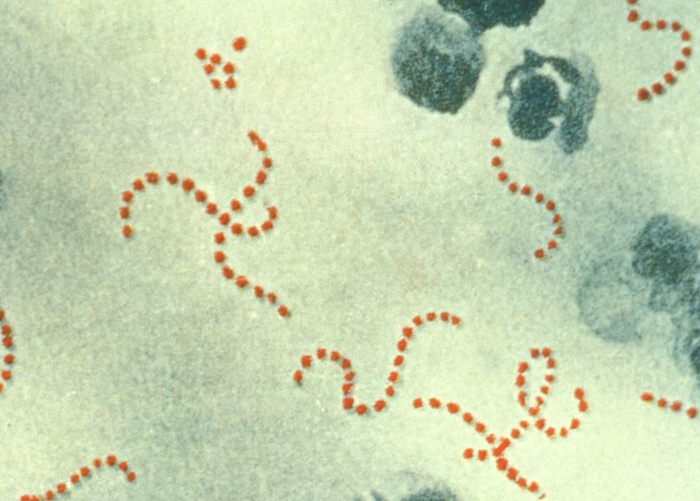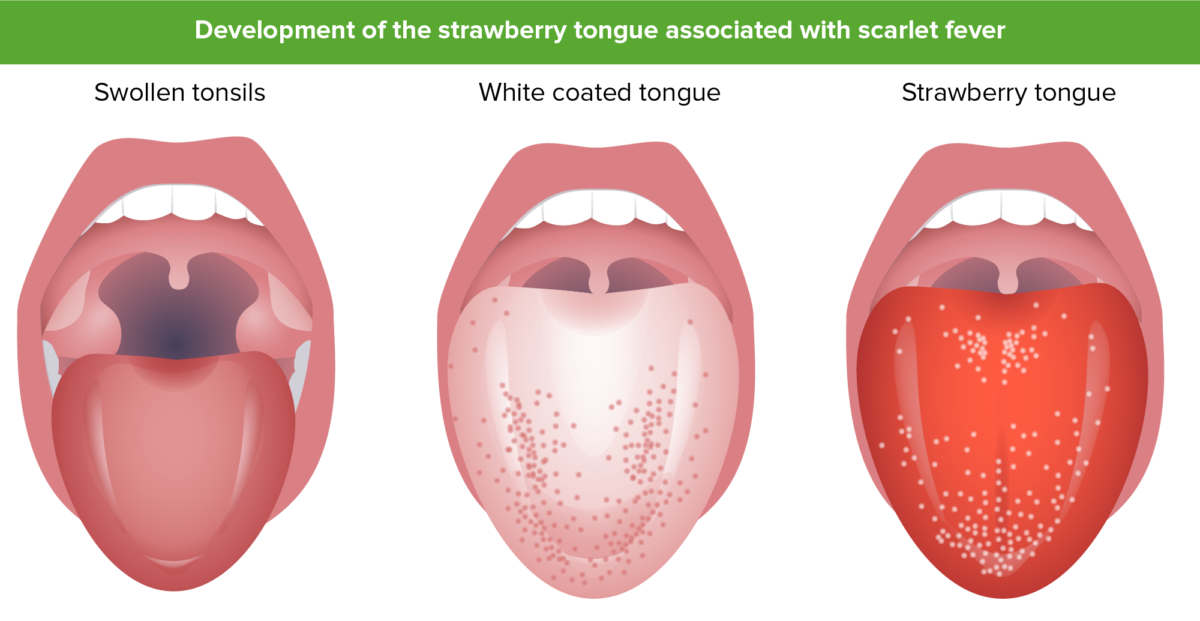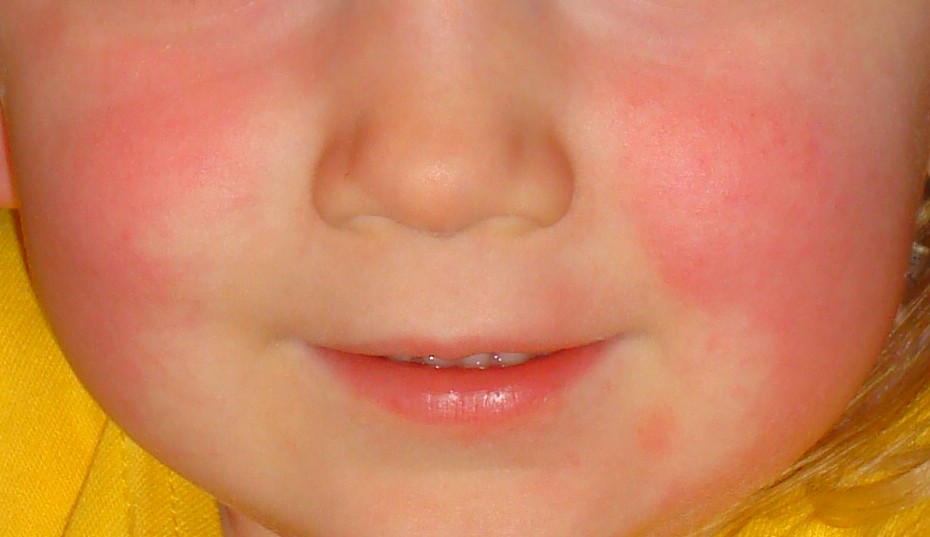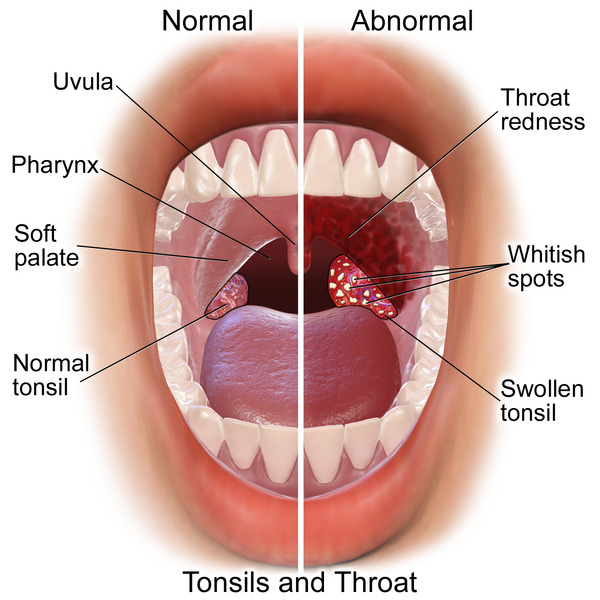Scarlet fever (or “scarlatina”) is a delayed-type skin reaction occurring in response to exposure to streptococcal pyrogenic exotoxins. It is considered a nonsuppurative complication of streptococcal infection (commonly pharyngitis, but also seen with pyoderma or wound infections) by Streptococcus pyogenes (group A streptococcus) that is more commonly seen in children. Incidence peaks during the winter and spring in temperate climates. The rash begins in the 1st 24–48 hours of illness. Starting in the face or neck, the exanthem spreads to the trunk and extremities but spares the palms and soles. With the infection, the face looks flushed, accompanied by circumoral pallor and a strawberry tongue (enlarged papillae). The minute papules feel like sandpaper. Diagnosis is usually made clinically and confirmed with a rapid antigen detection test (RADT) or throat culture. Treatment is with penicillin or amoxicillin.
Last updated: Dec 15, 2025
Scarlet fever Scarlet fever Infection with group a Streptococci that is characterized by tonsillitis and pharyngitis. An erythematous rash is commonly present. Scarlet Fever (also called “ scarlatina Scarlatina Infection with group a Streptococci that is characterized by tonsillitis and pharyngitis. An erythematous rash is commonly present. Scarlet Fever”) is a diffuse erythematous eruption or rash Rash Rocky Mountain Spotted Fever that occurs as a result of complications of infections Infections Invasion of the host organism by microorganisms or their toxins or by parasites that can cause pathological conditions or diseases. Chronic Granulomatous Disease with Streptococcus Streptococcus Streptococcus is one of the two medically important genera of gram-positive cocci, the other being Staphylococcus. Streptococci are identified as different species on blood agar on the basis of their hemolytic pattern and sensitivity to optochin and bacitracin. There are many pathogenic species of streptococci, including S. pyogenes, S. agalactiae, S. pneumoniae, and the viridans streptococci. Streptococcus pyogenes.

Streptococcus pyogenes (GAS)
Image: “Photomicrograph of Streptococcus pyogenes bacteria” by the Centers for Disease Control and Prevention. License: Public domain.
“Strawberry tongue”: early in the disease, the tongue could be covered by a white membrane or coating through which the papillae are seen. This layer sloughs off and reveals a bright red tongue with prominent papillae. A strawberry tongue results from a general inflammatory response early in the course of the disease.
Image by Lecturio.
Face looks flushed but has a “white mustache” or circumoral pallor, typical of scarlet fever.
Image: “Slapped cheeks and white mustache” by Estreya. License: CC BY-SA 4.0.
Common physical examination findings in acute exudative pharyngitis/tonsillitis (right half of the image), of which 1 of the most common causes is Streptococcus pyogenes
Image: “Tonsillitis” by BruceBlaus. License: Public domain.Selecting which patients Patients Individuals participating in the health care system for the purpose of receiving therapeutic, diagnostic, or preventive procedures. Clinician–Patient Relationship to treat with antibiotics can be complex:
Approach to patients Patients Individuals participating in the health care system for the purpose of receiving therapeutic, diagnostic, or preventive procedures. Clinician–Patient Relationship with fever Fever Fever is defined as a measured body temperature of at least 38°C (100.4°F). Fever is caused by circulating endogenous and/or exogenous pyrogens that increase levels of prostaglandin E2 in the hypothalamus. Fever is commonly associated with chills, rigors, sweating, and flushing of the skin. Fever and pharyngitis Pharyngitis Pharyngitis is an inflammation of the back of the throat (pharynx). Pharyngitis is usually caused by an upper respiratory tract infection, which is viral in most cases. It typically results in a sore throat and fever. Other symptoms may include a runny nose, cough, headache, and hoarseness. Pharyngitis who are clinically stable (i.e., no sign of imminent airway Airway ABCDE Assessment compromise):
Management consists of treating the causative agent of pharyngitis Pharyngitis Pharyngitis is an inflammation of the back of the throat (pharynx). Pharyngitis is usually caused by an upper respiratory tract infection, which is viral in most cases. It typically results in a sore throat and fever. Other symptoms may include a runny nose, cough, headache, and hoarseness. Pharyngitis, Streptococcus Streptococcus Streptococcus is one of the two medically important genera of gram-positive cocci, the other being Staphylococcus. Streptococci are identified as different species on blood agar on the basis of their hemolytic pattern and sensitivity to optochin and bacitracin. There are many pathogenic species of streptococci, including S. pyogenes, S. agalactiae, S. pneumoniae, and the viridans streptococci. Streptococcus pyogenes.
| Drug | Children/adolescents | Adults | |
|---|---|---|---|
| Medication for patients Patients Individuals participating in the health care system for the purpose of receiving therapeutic, diagnostic, or preventive procedures. Clinician–Patient Relationship with no penicillin Penicillin Rheumatic Fever allergy Allergy An abnormal adaptive immune response that may or may not involve antigen-specific IgE Type I Hypersensitivity Reaction | Penicillin Penicillin Rheumatic Fever V | 500 mg every 8–12 hours for 10 days | |
| Penicillin Penicillin Rheumatic Fever G | 1.2 million units IM (single dose) | ||
| Amoxicillin Amoxicillin A broad-spectrum semisynthetic antibiotic similar to ampicillin except that its resistance to gastric acid permits higher serum levels with oral administration. Penicillins | 50 mg/kg/day once daily or in divided doses every 12 hours for 10 days (maximum daily dose: 1000 mg) | 500 mg twice a day for 10 days | |
| Medication for patients Patients Individuals participating in the health care system for the purpose of receiving therapeutic, diagnostic, or preventive procedures. Clinician–Patient Relationship with mild reaction to penicillin Penicillin Rheumatic Fever | Cephalexin (1st-generation cephalosporin Cephalosporin Multidrug-resistant Organisms and Nosocomial Infections) | 40 mg/kg/day divided every 12 hours for 10 days | 500 mg twice a day for 10 days |
| Cefuroxime (2nd-generation cephalosporin Cephalosporin Multidrug-resistant Organisms and Nosocomial Infections) | 10 mg/kg/dose orally twice daily for 10 days (maximum: 250 mg/dose) | 250 mg orally twice daily for 10 days | |
| Cefdinir (3rd-generation cephalosporin Cephalosporin Multidrug-resistant Organisms and Nosocomial Infections) | 14 mg/kg/day in divided doses every 12–24 hours for 10 days (maximum: 600 mg/day) | 300 mg orally twice daily for 5–10 days or 600 mg orally once daily for 10 days | |
| Medications for patients Patients Individuals participating in the health care system for the purpose of receiving therapeutic, diagnostic, or preventive procedures. Clinician–Patient Relationship with severe penicillin Penicillin Rheumatic Fever allergy Allergy An abnormal adaptive immune response that may or may not involve antigen-specific IgE Type I Hypersensitivity Reaction | Azithromycin Azithromycin A semi-synthetic macrolide antibiotic structurally related to erythromycin. It has been used in the treatment of Mycobacterium avium intracellulare infections, toxoplasmosis, and cryptosporidiosis. Macrolides and Ketolides | 12 mg/kg/dose once daily for 5 days (maximum: 500 mg/dose) | 12 mg/kg/dose once daily for 5 days (maximum: 500 mg/dose) |
| Clindamycin Clindamycin An antibacterial agent that is a semisynthetic analog of lincomycin. Lincosamides | 7 mg/kg/dose twice daily (maximum: 250 mg/dose) | 300 mg orally 3 times daily for 10 days |
| Number | Other names for the disease | Etiology | Description |
|---|---|---|---|
| 1st disease 1st disease Measles (also known as rubeola) is caused by a single-stranded, linear, negative-sense RNA virus of the family Paramyxoviridae. It is highly contagious and spreads by respiratory droplets or direct-contact transmission from an infected person. Typically a disease of childhood, measles classically starts with cough, coryza, and conjunctivitis, followed by a maculopapular rash. Measles Virus |
|
Measles Measles Measles (also known as rubeola) is caused by a single-stranded, linear, negative-sense RNA virus of the family Paramyxoviridae. It is highly contagious and spreads by respiratory droplets or direct-contact transmission from an infected person. Typically a disease of childhood, measles classically starts with cough, coryza, and conjunctivitis, followed by a maculopapular rash. Measles Virus morbillivirus Morbillivirus A genus of the family paramyxoviridae (subfamily paramyxovirinae) where the virions of most members have hemagglutinin but not neuraminidase activity. All members produce both cytoplasmic and intranuclear inclusion bodies. Measles virus is the type species. Measles Virus |
|
| 2nd disease |
|
Streptococcus Streptococcus Streptococcus is one of the two medically important genera of gram-positive cocci, the other being Staphylococcus. Streptococci are identified as different species on blood agar on the basis of their hemolytic pattern and sensitivity to optochin and bacitracin. There are many pathogenic species of streptococci, including S. pyogenes, S. agalactiae, S. pneumoniae, and the viridans streptococci. Streptococcus pyogenes |
|
| 3rd disease 3rd disease An acute infectious disease caused by the rubella virus. The virus enters the respiratory tract via airborne droplet and spreads to the lymphatic system. Rubella Virus |
|
Rubella Rubella An acute infectious disease caused by the rubella virus. The virus enters the respiratory tract via airborne droplet and spreads to the lymphatic system. Rubella Virus virus Virus Viruses are infectious, obligate intracellular parasites composed of a nucleic acid core surrounded by a protein capsid. Viruses can be either naked (non-enveloped) or enveloped. The classification of viruses is complex and based on many factors, including type and structure of the nucleoid and capsid, the presence of an envelope, the replication cycle, and the host range. Virology |
|
| 4th disease |
|
Due to Staphylococcus aureus Staphylococcus aureus Potentially pathogenic bacteria found in nasal membranes, skin, hair follicles, and perineum of warm-blooded animals. They may cause a wide range of infections and intoxications. Brain Abscess strains that make epidermolytic (exfoliative) toxin |
|
| 5th disease | Erythema Erythema Redness of the skin produced by congestion of the capillaries. This condition may result from a variety of disease processes. Chalazion infectiosum | Erythrovirus or parvovirus B19 Parvovirus B19 Primate erythroparvovirus 1 (generally referred to as parvovirus B19, B19 virus, or sometimes erythrovirus B19) ranks among the smallest DNA viruses. Parvovirus B19 is of the family Parvoviridae and genus Erythrovirus. In immunocompetent humans, parvovirus B19 classically results in erythema infectiosum (5th disease) or “slapped cheek syndrome.” Parvovirus B19 (primate erythroparvovirus Erythroparvovirus Parvovirus B19 1) |
|
| 6th disease |
|
Human herpesvirus 6B or human herpesvirus 7 |
|
Diagnosis Codes:
This code is used to diagnose Scarlet Fever, an illness that develops in some people who have strep throat, characterized by a bright red rash, high fever, and a “strawberry tongue.”
| Domain | Code | Description |
|---|---|---|
| ICD-10-CM | A38.9 | Scarlet fever Scarlet fever Infection with group a Streptococci that is characterized by tonsillitis and pharyngitis. An erythematous rash is commonly present. Scarlet Fever, uncomplicated |
| ICD-11 | 1B53 | Scarlet fever Scarlet fever Infection with group a Streptococci that is characterized by tonsillitis and pharyngitis. An erythematous rash is commonly present. Scarlet Fever |
| SNOMED CT | 24045000 | Scarlet fever Scarlet fever Infection with group a Streptococci that is characterized by tonsillitis and pharyngitis. An erythematous rash is commonly present. Scarlet Fever (disorder) |
Evaluation & Workup:
These codes are used to order the tests to confirm the underlying Group A Streptococcus Group A Streptococcus A species of gram-positive, coccoid bacteria isolated from skin lesions, blood, inflammatory exudates, and the upper respiratory tract of humans. It is a group a hemolytic Streptococcus that can cause scarlet fever and rheumatic fever. Postinfectious Glomerulonephritis infection, including a rapid antigen detection Antigen detection Respiratory Syncytial Virus test for quick results and a throat Throat The pharynx is a component of the digestive system that lies posterior to the nasal cavity, oral cavity, and larynx. The pharynx can be divided into the oropharynx, nasopharynx, and laryngopharynx. Pharyngeal muscles play an integral role in vital processes such as breathing, swallowing, and speaking. Pharynx: Anatomy culture as the gold standard.
| Domain | Code | Description |
|---|---|---|
| CPT | 87880 | Infectious agent antigen detection Antigen detection Respiratory Syncytial Virus by immunoassay with direct optical observation; Streptococcus Streptococcus Streptococcus is one of the two medically important genera of gram-positive cocci, the other being Staphylococcus. Streptococci are identified as different species on blood agar on the basis of their hemolytic pattern and sensitivity to optochin and bacitracin. There are many pathogenic species of streptococci, including S. pyogenes, S. agalactiae, S. pneumoniae, and the viridans streptococci. Streptococcus, group A |
| CPT | 87081 | Culture, presumptive, pathogenic organisms, screening Screening Preoperative Care only |
Medications:
These codes are used to prescribe antibiotics, such as penicillin Penicillin Rheumatic Fever or amoxicillin Amoxicillin A broad-spectrum semisynthetic antibiotic similar to ampicillin except that its resistance to gastric acid permits higher serum levels with oral administration. Penicillins, which are essential for treating the strep infection, resolving symptoms, and preventing serious post-streptococcal complications.
| Domain | Code | Description |
|---|---|---|
| RxNorm | 834 | Amoxicillin Amoxicillin A broad-spectrum semisynthetic antibiotic similar to ampicillin except that its resistance to gastric acid permits higher serum levels with oral administration. Penicillins (ingredient) |
| RxNorm | 7979 | Penicillin Penicillin Rheumatic Fever V (ingredient) |
| ATC | J01CA04 | Amoxicillin Amoxicillin A broad-spectrum semisynthetic antibiotic similar to ampicillin except that its resistance to gastric acid permits higher serum levels with oral administration. Penicillins |
Complications & Supportive Procedures:
These codes are used to document the serious, delayed, non-suppurative Non-Suppurative Scarlet Fever complications of an untreated streptococcal infection, including acute rheumatic fever Rheumatic fever Acute rheumatic fever (ARF) is an autoimmune inflammatory process that usually follows Streptococcal pharyngitis. Acute rheumatic fever usually occurs 2-4 weeks after an untreated infection and affects the heart, skin, joints, and nervous system. Rheumatic Fever (affecting the heart and joints) and post-streptococcal glomerulonephritis (affecting the kidneys Kidneys The kidneys are a pair of bean-shaped organs located retroperitoneally against the posterior wall of the abdomen on either side of the spine. As part of the urinary tract, the kidneys are responsible for blood filtration and excretion of water-soluble waste in the urine. Kidneys: Anatomy).
| Domain | Code | Description |
|---|---|---|
| ICD-10-CM | I00 | Rheumatic fever Rheumatic fever Acute rheumatic fever (ARF) is an autoimmune inflammatory process that usually follows Streptococcal pharyngitis. Acute rheumatic fever usually occurs 2-4 weeks after an untreated infection and affects the heart, skin, joints, and nervous system. Rheumatic Fever without heart involvement |
| ICD-10-CM | N00.9 | Acute nephritic syndrome Nephritic syndrome Nephritic syndrome is a broad category of glomerular diseases characterized by glomerular hematuria, variable loss of renal function, and hypertension. These features are in contrast to those of nephrotic syndrome, which includes glomerular diseases characterized by severe proteinuria, although there is sometimes overlap of > 1 glomerular disease in the same individual. Nephritic Syndrome with unspecified morphologic changes |